La Réunion is beautiful. It’s also intense. While visiting La Réunion island, I expected hikes and views, markets, and Creole food. I got all of that. But I also climbed more than I ever had before, nearly gave up on a trail, slept in a gîte without a single window, and got rescued by someone’s GPS watch on a foggy volcanic ridge.
My husband and I went to visit his best friend and our témoin, who had recently moved there, and we ended up with the kind of local insight you can’t pay for. Still, there were things we got wrong. Between local insight and trial and error, I picked up a lot of things I wish I’d known earlier. If you’re planning a trip to La Réunion, especially your first, this post will help you make better choices, avoid the typical surprises, and enjoy the island without wasting time.
First Time Travel to La Réunion Guide
You’ll find tips on:
- Safety, including what I noticed about swimming and solo travel
- Hiking, including trail timing and fitness levels
- Driving, and why some roads are best avoided
- Packing, especially for mountain weather
- Food, including my favorite local dishes
- Where to stay, and what to ask before booking
- La Réunion visa requirements, money tips, language, and mobile signal.
This guide is built from experience. It’s opinionated, practical, and honest. If you’re searching for La Réunion travel tips for first-timers, start here.
In short: If I had to give La Réunion travel tips for first-timers in one line: slow down, prepare for the terrain, and talk to locals.
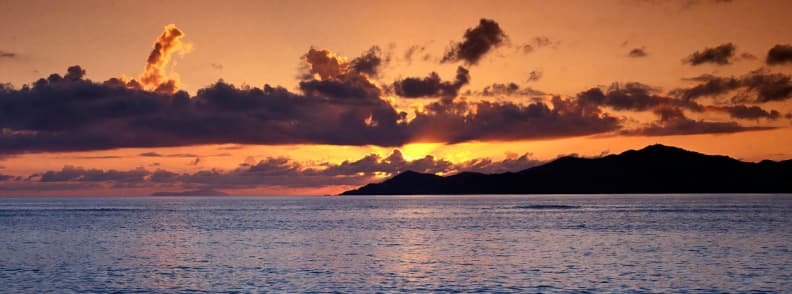
Is La Réunion Safe for Tourists?
I didn’t travel solo, but I paid attention. Safety matters no matter who you’re with, and La Réunion has a reputation that can make people hesitate, especially when it comes to the ocean.
Here’s what stood out to me:
- People are friendly. Genuinely friendly. At markets, in restaurants, on hiking trails. You don’t get the sense that tourists are seen as intruders or targets. I never felt watched or out of place. Locals often gave directions or just chatted.
- Towns felt safe. We walked around Saint-Leu and Bras-Panon in the evening without any issues. I wouldn’t walk around isolated roads alone after dark, but that’s true anywhere.
- The bigger concern is natural safety. If you’ve read anything about the island, you’ve seen the headlines about shark attacks in La Réunion. Yes, they’ve happened. But most are linked to surfing in unprotected areas. Locals don’t swim just anywhere, and you shouldn’t either.
I only swam once in the calm lagoon at La Saline, behind the reef. Would have loved to do it more but we just got caught up in everything else the island has to offer. Anyway, the water was shallow and peaceful, with plenty of families around. Is it safe to swim in La Réunion lagoons? Yes, if you stick to designated spots like this one. There are some of the La Réunion beaches with shark nets, and they’re clearly marked. Locals know which areas are safe, and they follow those guidelines.
That said, I know a photographer who scuba dives regularly off La Réunion’s coast. She’s never had a problem with sharks. In fact, she says they’re surprisingly hard to find. That should tell you something. Still, caution matters. My swimming safety tips for La Réunion: avoid open water, stick to netted or lagoon areas, pay attention to signs, and if you’re unsure, ask locals. They know. - Hiking is where most people get caught out. The trails are well-marked, but the weather changes fast and the climbs are often steeper than they look on paper. The island’s nickname, Île Intense, makes sense once you’re out there. I’ve written more about that below, especially what happened on the way to Les Orangers.
If you’re solo and planning to hike, start early, tell someone where you’re going, and ask locals if the route is open. Avoid hiking in the afternoon unless it’s a short trail. I’ve seen fog roll in so thick you couldn’t see ten steps ahead.
So, is La Réunion safe to travel alone? Is it safe for solo travelers? I think yes but it rewards good planning. My La Réunion safety tips in a nutshell are: stay in a gîte, stick to marked paths, swim only where locals swim, and ask questions. The island is remote, but it’s not closed off. People will help you if you need it.

What I Wish I Knew About Hiking in La Réunion
You can’t visit La Réunion and skip the hikes. Even if you’re not a hiker, the island lures you in. The landscapes are too dramatic, the trails too tempting. But I underestimated just how physically and mentally demanding some of the trails would be, and I definitely wasn’t prepared for all of it.
We hiked almost every two days. Some trails were short and scenic. Some were long and scenic. And one nearly broke me.
Let’s talk terrain. Trails are well-marked, but they’re often vertical. Not just steep but vertical. My watch recorded over 60 floors climbed on the last stretch to Les Orangers in the Cirque de Mafate. It was getting dark when I sat down and told the others to leave me there. They didn’t. I’m glad they didn’t. But I meant it at the time.
If you’re planning to hike in Cirque de Mafate, be honest about your fitness. There’s no road access. You carry everything in, and you climb more than you think. I thought I was ready. I wasn’t. The final stretch to the gîte felt endless. Hiking the Cirque de Mafate is one of the most challenging treks in La Réunion, but also one of the most rewarding. You’ll earn your view and your dinner.
But not every trail is like that. There are routes for all levels. If you’re searching for the best hikes in La Réunion for beginners, start with Cap Jaune near Vincendo or Voile de la Mariée in Salazie. These are also two of the best easy hikes in La Réunion with great views. They’re short, scenic, and don’t demand much more than sturdy shoes and water.
Then there’s the volcano. The Piton de la Fournaise hike difficulty depends on what route you take. Stop at the main viewpoint and it’s relatively easy. Go further, and you’re in for long, exposed terrain with slippery sections and almost no shade. If it’s erupting, that motivates a lot of people but the crowds don’t make it easier. Be realistic about what you can handle.
Timing matters. Hiking guides for La Réunion will tell you the same: dry season is best, mornings are safer, and fog is your enemy. We started at 3 AM for Piton de Bert and still ended up hiking through the whiteout. We were lucky to meet a stranger with a GPS watch on Piton de Bert. He ended up hiking with us, and without that device, we might have gotten properly lost. We actually helped other people find their way back to the trail. You can’t always rely on trail markings, especially when there’s fog.
Pack for extremes as if you’re hiking in both summer and winter. You’ll sweat on the coast and freeze in the highlands. Conditions shift fast with elevation. You need layers, a proper rain jacket, real food, water, and if you have one, a GPS or downloaded map. Don’t expect any mobile phone signal in the mountains. We didn’t notice signal loss much because we weren’t on our phones but if you rely on them for navigation, you’ll need a backup.
La Réunion rewards hikers, but it doesn’t go easy on anyone. The views are worth every step, but plan properly, start early, and don’t let the tropical setting fool you into thinking the trails are easy. Even the best hikes in La Réunion for beginners ask for decent shoes and common sense. And the challenging treks in La Réunion like hiking the Cirque de Mafate or doing the full Piton de la Fournaise loop test everything else.
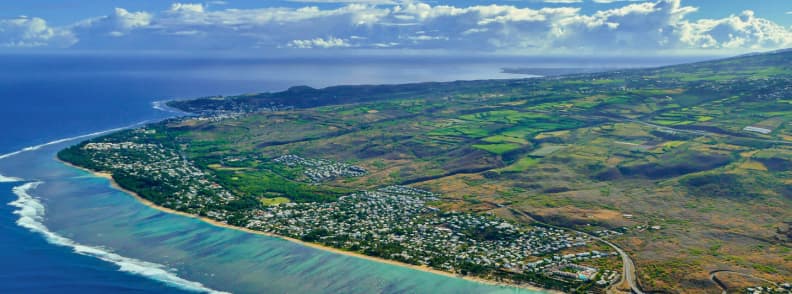
What to See in La Réunion (Beyond the Hikes)
Most people go for the hikes. But La Réunion offers a lot more than just trails.
If you’re looking for variety, this island delivers. And not just in the “hit every viewpoint” kind of way. It’s one of the few places where you can hike a volcano in the morning, swim in a black sand lagoon by lunch, and explore lava tunnels by afternoon. And it all feels natural, not packaged.
Beaches Worth Planning Around
I didn’t swim much, but I paid attention. The best beaches in La Réunion for families are the lagoon-protected ones on the west coast, and La Saline and L’Ermitage are the calmest. You’ll see locals bringing chairs, snacks, and full coolers. Shallow water, reef protection, and space to stretch out.
If you’re looking for the best snorkeling spots in La Réunion, head to the northern end of L’Ermitage or the reef edge near Saint-Leu. Water clarity depends on the day, but the coral is there and so are the fish. Just don’t expect Maldives-style visibility every time.
For something different, check out the black sand beaches in La Réunion, like Étang-Salé. It’s not the safest for swimming, but the contrast of dark sand, green palms, and deep blue ocean is unreal. Go for the scenery and the photos, not the dip.
Volcanoes, Tunnels, and Other Ways to Feel Small
Visiting Piton de la Fournaise isn’t just about hiking it. Even if you don’t walk far, the road to Pas de Bellecombe is dramatic and worth the drive. The landscape shifts into something lunar. Some days it’s covered in clouds. Some days it’s pure blue sky and endless flow fields. Either way, you feel like you’re on another planet.
If you want a closer look, you can join volcano tours in La Réunion that offer geological insights, transport, or access to specific areas. But if you’re short on time, even just standing at the viewpoint gives you the scale.
The lava tunnels in La Réunion were something I didn’t have time for but I heard great things from friends. Guided tours take you underground through old flow systems. It’s not a casual walk (you’ll need a helmet and light) but it’s one of the most unusual things to do on the island.
Visiting La Réunion Island Is More Than a Checklist
La Réunion isn’t built for ticking off sights. It’s better if you slow down. Walk a little further. Talk to someone. Stop for that fruit stand on the side of the road.
If you’re planning a longer trip or doing Reunion Island backpacking, this flexibility becomes the whole point. And if you’re into Reunion eco-tourism, the island makes it easy with local farms, low-impact stays, endemic species, and people who are deeply tied to their land.
The best attractions here are the ones that aren’t signposted. Let people point you to them. That’s how I found most of the places I liked best.
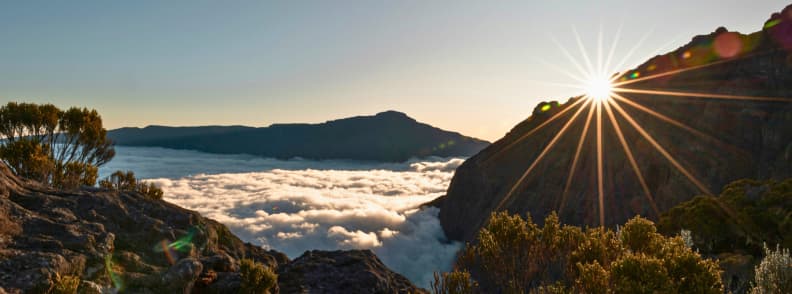
When Is the Best Time to Visit La Réunion (Especially for Hiking?)
The best time to visit La Réunion for hiking is during the dry season, from May to October. If you’re wondering when is the best season to visit La Réunion, this is it, especially for trail conditions and outdoor plans. Cooler temperatures in the highlands, more stable weather, and fewer washouts. But even during the dry season La Réunion is known for, things can shift quickly.
We left at 3 a.m. for Piton de Bert, hoping to catch the sunrise and maybe see Piton de la Fournaise erupting. The volcano was active, and that trail offered a distant view over the lava flow. We got lucky if only for a few seconds. The fog opened just enough to catch a faint red glow. Then it slammed shut.
We missed the sunrise. The clouds didn’t lift in time. It was cold, damp, and grey. I was glad for the layers I’d packed, but I wouldn’t have minded a bit more warmth. I was shaking.
That’s why it helps to understand La Réunion climate by month instead of relying on average temperatures or hoping for good luck. La Réunion trail conditions May to October are generally solid, but you still need to plan like it might turn on you.
You can be sweating on the beach in Saint-Leu and freezing an hour later on a ridge in Cirque de Mafate. Microclimates on the island are no joke.
If you’re hiking in La Réunion during dry season, expect mornings to be your safest window. Fog and clouds usually roll in by mid-afternoon, and visibility can disappear fast. For longer hikes, earlier is better. Some people start at 2 or 3 a.m. if they want to catch sunrise views… just don’t expect the island to cooperate.
Next time, I’d still go in the dry season but aim for early October. I think it’s the best month to hike La Réunion if you want cooler trails without the chill. It’s just warm enough, the trails are still in good shape, and it comes before cyclone season kicks in.
If you’re planning a hiking trip, check the weather but don’t trust it fully. The best time to visit La Réunion for hiking is dry season, yes, but your packing list needs to cover every possibility.
La Réunion Climate by Month
Understanding the climate is key to planning the right kind of trip. La Réunion climate by month can vary more than people expect, especially with the island’s steep terrain and microclimates.
Here’s what you need to know:
- January–March weather is hot and humid, and there is a cyclone risk. It’s the best time to go diving and enjoy quiet beaches. Avoid long hikes and road trips.
- April is the transition season. It comes with fewer crowds but it can still be wet.
- May is dry and cooler. It’s the start of the best season to visit La Réunion for hiking.
- June–July are the coolest months. They offer clear air and great views. The downside is the cold nights in the mountains.
- August is dry and crisp. It’s high season for locals so book everything ook early.
- September is still dry and the weather is warming up. It’s the month with the best hiking. However, some trails are busy.
- October is warm and still dry. Ideal for hiking + coast combo. It’s the best month to hike La Réunion.
- November is warmer but wetter. Nice for snorkeling and taking advantage of low crowds. The trails are slippery.
- December is humid, but there are mangoes! Enjoy swimming, delicious exotic fruit, and the festive season. The rain starts creeping in.
Even during the May-October dry season, weather in the highlands changes fast. You can be in full sun one minute, then in thick fog the next. Always check forecasts for the specific area you’re heading to, not just the coast.
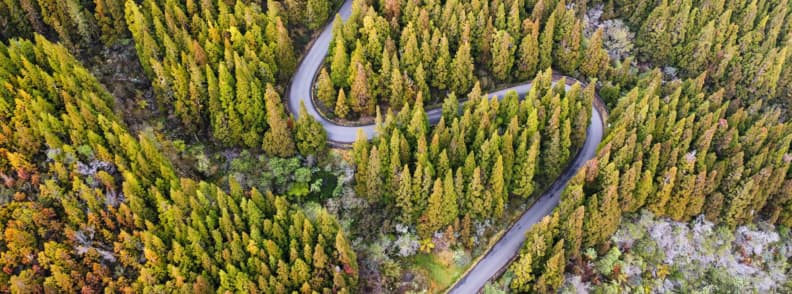
Renting a Car in La Réunion & WhyYou Need To Do It
If you’re trying to decide whether you need to rent a car in La Réunion, stop wondering. You do. La Réunion public transport exists, but it won’t get you everywhere you need to go like trailheads, volcanic viewpoints, remote gîtes, and even some beaches. And while there are taxis, taxi fares in La Réunion add up fast, especially if you’re heading into the highlands.
Unless you’re spending your entire trip in one coastal town, you’ll waste time and money trying to arrange rides. Renting gives you flexibility and on this island, that matters a lot.
We didn’t rent through a company. We knew someone local who rents out their own car. That’s common on the island. Locals often rent their cars to people they know, friends of friends, or other travelers they trust.
My husband did all the driving. He prefers manual, which helped. Manual is the default in La Réunion. If you need an automatic car rental La Réunion, book ahead. They’re scarce and more expensive. Don’t assume you’ll get one last minute, especially in high season. And if you’re not used to manual, don’t wait until you’re halfway up a mountain road to learn.
Driving Tips for La Réunion
Driving in La Réunion for first-time visitors isn’t hard, but it’s not laid-back either. The coastal roads are manageable. The inland ones twist, narrow, and rise fast and they don’t come with warnings.
We didn’t need a 4×4, but we stayed alert. The road to Cascade Niagara was full of potholes. The approach to Cascade du Chien felt barely drivable. These are the kinds of routes where La Réunion car rental tips for mountain roads apply: take your time, know your limits, and ask locals before committing.
If it’s your first time, here’s what I’d keep in mind:
- Locals drive fast, but they’re used to the roads. Don’t try to match them. Let them pass.
- Mountain roads have sharp turns with no guardrails. Go slow.
- Rain can hit one side of the island and leave the other dry. Roads get slick fast.
- Expect traffic jams. Our friends sometimes preferred to leave at 5 am and be at work 2 hours in advance than spend 3 hours or more in traffic jams later.
Parking in Saint-Denis is a small nightmare. Tight, chaotic, and stressful. Narrow streets, unclear signage, and not nearly enough spaces. If you can avoid driving into the capital during peak hours, do.
La Réunion car rental tips for first-time visitors? Book early. Know what you’re driving. Skip the lowest category if you’re going off the main roads. The island demands more from the driver than the car… but not by much.
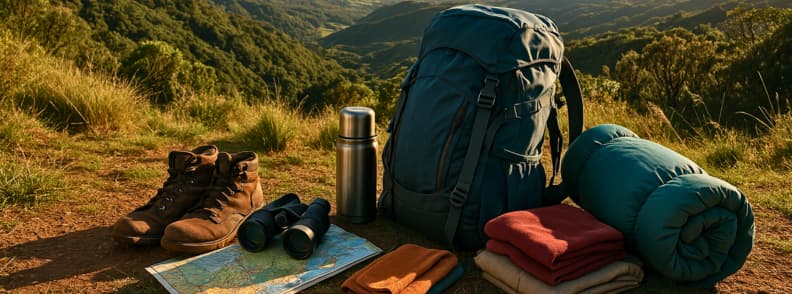
What to Pack for a Trip to La Réunion (Especially for Hikers)
If I could redo one thing before the trip, it would be packing better for the volcano. I thought I had the basics covered. I didn’t. On the Piton de Bert trail, in the cold, the dark, and the fog, I realized quickly that my gear wasn’t enough.
La Réunion’s weather changes with altitude. The coast might be sunny and warm, but the highlands can feel like another season entirely. If you’re wondering what to pack for hiking in La Réunion, start with the assumption that you’ll be dealing with heat, wind, cold, and rain sometimes on the same trail.
Here’s what I’d pack next time, no questions asked:
Essentials for Hiking
- The best hiking shoes for La Réunion are waterproof, grippy, and already broken in. The terrain is steep, rocky, and slippery when wet. I saw people in trainers and flip-flops. I also saw them turn around halfway up.
- A good rain jacket. Lightweight and wind-resistant. You’ll need it.
- Layers. A breathable base layer, a fleece/light mid-layer, something to block the wind.
- Headlamp or torch. If you’re doing early hikes, you can’t rely on your phone.
- Trail snacks and plenty of water. You won’t find cafés or food stalls out there.
- Sun protection. Even on cloudy days. High-altitude sunburn is real.
- A small first aid kit. Just in case. Blisters happen fast here.
Clothing for Hiking in Tropical Climate La Réunion
- Quick-dry tops
- Hiking trousers or leggings (avoid jeans)
- Moisture-wicking socks
- Hat and sunglasses
- Light gloves for early starts.
One thing that saved us on the Piton de Bert trail was a GPS hiking watch `but it wasn’t mine. We met a stranger at the trailhead and ended up walking together. Visibility was so bad we couldn’t see the markers. His watch kept us on track. At one point, we even helped another group find their way back to the path.
If I’d had to rely on my phone, we would’ve been in trouble. There was no signal, and even the downloaded maps weren’t much use in that fog.
La Réunion hiking gear tips come down to this: don’t pack light, pack right. You’ll thank yourself when the weather turns.
Creole Culture, Local Life & Markets in La Réunion
You can’t understand the island without understanding Creole culture La Réunion. It’s not a sideshow, it’s the thread that ties everything together. Language, food, music, architecture, and rhythms. You see it in the street murals. You hear it in the way people talk, sing, laugh. You taste it with every meal.
It’s a mix of African, Malagasy, Indian, Chinese, and French roots. All adapted, not copied. People live that mix. It’s not just something they perform for tourists.
If you’re lucky enough to be here during one of the traditional festivals in La Réunion, go. The Fête du Choca, the Cavadee, and Chinese New Year all show different sides of the island’s heritage. Some are religious, some are seasonal, but all are community events with dancing, drumming, food, and sometimes processions in the street. Ask around. These events don’t always show up online.
And if you’re not here during a big celebration? Go to a market.
Local markets in Saint-Denis and beyond
The local markets Saint-Denis are noisy, colorful, and packed with everything from vegetables and fresh herbs to crafts, samosas, and incense. The Grand Marché is the best for souvenirs, but the food stalls near the Petit Marché were where I spent the most time.
Elsewhere on the island, every town seems to have a weekly market, usually in the morning. It’s where you get real insight into how people eat, what’s in season, and what daily life looks like. I adored the one in Saint-Paul. It was the first place our friend took us when we arrived in La Réunion.
These markets are also the easiest place to try Creole street food (fried bread, spicy sauces, grilled things you can’t name) and the perfect lead-in to one of the best parts of the island experience: the delicious local food.

Must-Try Creole Food in La Réunion Restaurants
I didn’t go to La Réunion for the food. But I came back thinking about it more than the beaches. Creole food here is made with real ingredients and strong hands. Coconut, turmeric, vanilla, sugar cane, smoky rougails, rum-infused everything. Dishes are simple but layered. You can taste where the food comes from: farms, gardens, even backyards. And that makes it one of the most memorable parts of being on the island.
Must try Creole food in La Réunion restaurants
- Bol renversé: a rice bowl, flipped upside down, with vegetables, meat, or egg and a light sauce. Nothing showy, just perfect proportions.
- Vanilla duck with speculoos: sweet, rich, unexpected. I had it at Villa Vanille for a belated birthday meal and I still think about it.
- Caris and rougails: you’ll find them on every menu. But they’re not all equal. The best ones are slow-cooked, heavy on flavor, and come with rice and lentils on the side.
If you’re after traditional dishes of La Réunion, these are the staples. But what matters more is where you eat them.
One of the things I loved most was how local the food really is. You won’t find watered-down versions or tourist-friendly tweaks. We ate at tiny places with handwritten menus and sat down at shared tables with strangers. At Ferme Auberge Eva Annibal, we swapped hiking stories over chouchou gratin and rhum arrangé. That night stayed with me.
Where to eat in Saint-Denis
Looking for where to eat in Saint-Denis or more specifically where to eat local cuisine in Saint-Denis? Don’t stick to the city center restaurants. Instead:
- Small snack bars around Rue de Paris: basic, fast, and better than they look.
- Local markets: especially good for grilled meats, fresh juices, and sweet fritters.
- Ask your hosts. Seriously. The best meal in Saint-Denis isn’t online at all.
If you’re browsing for a La Réunion food guide, skip the tourist-friendly places with laminated menus in five languages. Follow the smoke, not the stars. Look for hand-painted signs, blackboards, or smoke drifting out from a grill in someone’s back garden. If it feels like someone’s aunt is in the kitchen it’s probably going to be great.
Eat where locals eat. Try what’s on the board. Be open to flavors you can’t name. You’ll eat better and spend less. And if you’re open to trying new flavors or unfamiliar sauces, you’ll likely leave with a new favorite dish or three.
Visa Rules, Currency & Language: What No One Explained Clearly
La Réunion is part of France, but that doesn’t mean the travel logistics are straightforward. I didn’t run into visa problems, but the questions started early. Also, from what I’ve seen, I’m not the only one who got confused by the entry rules, currency, and language.
La Réunion Visa Requirements: Check Twice
If you’re from the EU or the UK, you don’t need a visa for short stays. But for everyone else, it depends. La Réunion follows French visa policy, but it’s not part of the Schengen area. That distinction trips people up constantly.
A Schengen visa for France won’t always get you into La Réunion. You need to check whether your visa includes French overseas territories. If not, you’ll need to apply separately.
Here’s what people commonly ask (and Google can give mixed answers):
- Do I need a visa to visit La Réunion from USA?
Yes, unless you’re covered by a French overseas visa waiver. La Réunion visa requirements for USA => Depends on trip length and purpose. Check France-Visas. - Do I need a visa to visit La Réunion from Romania?
No, Romania is an EU member and has also been integrated fully in the Schengen Area on 1 January 2025. Yay! La Réunion visa requirements for Romania => No visa needed for tourism. - La Réunion Schengen visa does not apply unless specifically extended to overseas departments.
Bottom line: always search La Réunion visa requirements for [your nationality] before booking flights. Don’t assume anything.
Currency: Bring Cash
La Réunion uses the euro. The Euro exchange rate in La Réunion is exactly the same as in mainland France. But prices aren’t always cheap. Think small-town France with island transport costs layered in.
Cash is essential in rural areas. Cards work in big supermarkets, petrol stations, and most restaurants, but you’ll need coins and small notes for local markets, roadside fruit stands, and family-run gîtes. We used cash nearly every day, especially in the mountains.
Language: French is not optional
Do they speak English in La Réunion? Rarely. French is the default, and Créole is used in conversation, especially outside the main towns. I speak French, so I was fine. But if you don’t, you’ll probably struggle in rural areas.
I’d recommend learning some basics or using an offline translator. Don’t count on menus, signage, or customer service being available in English.
The Gîte I’ll Never Forget
Now, let’s talk about where I stayed on my birthday.
My husband booked a place that looked perfect in the listing: sea view, mountain view, inner courtyard view, breakfast included. What it didn’t mention: no windows to enjoy those views, and actually not even a door between the toilet and the bed, visible dampness, and a strange acoustic echo that made every small sound uncomfortably loud. We slept badly. It was… a memorable night. But the homemade breakfast the next morning, on their shaded patio? Almost made up for it.
If you’re booking accommodation, ask questions. Don’t just rely on nice photos. Get confirmation on privacy, layout, and basic amenities. And if you’re celebrating something special (like a birthday) triple-check the place.
La Réunion doesn’t run on international hotel standards. It runs on local rhythm. That’s part of the charm but also a reason to read (and even question) the fine print.
5 Tiny Things That Made a Huge Difference
It’s always the little things. The stuff no one mentions, but you end up relying on more than anything else. These aren’t major gear recommendations. They’re small habits, objects, or decisions that made our trip smoother, cheaper, or less stressful.
Here are five things I was genuinely glad we brought or did:
1. A reusable shopping bag
Shops don’t give out free bags. Some don’t offer any at all. We used ours constantly for groceries, beach gear, hiking snacks, and wet clothes. If you forget yours, you’ll end up juggling baguettes in the car park.
2. Mosquito repellent
Even during the dry season, the moment you sit outside at dusk, they find you. Especially in Bras-Panon and near the coast. Bring something that works and doesn’t smell too awful. Locals might recommend citronella or clove-infused blends.
3. Small cash and coins
Markets, small eateries, boulangeries, and some gîtes only take cash. It’s easy to forget how often you need exact change. I kept a few coins in every bag.
4. Offline maps and a decent hiking app
Mobile signal is unreliable in the mountains. We were too caught up in the moment to notice most of the time, but when we needed help, we were lucky. The guy we met on the Piton de Bert trail had a GPS watch. Without it, we (and the people we helped) would’ve wandered in the fog for hours. Don’t count on your phone alone.
5. Booking gîtes and huts in advance
If you’re hiking into places like Cirque de Mafate, book early. These stays fill up, especially the better ones. After a long hike, you don’t want to find out the only available room is windowless with no door or proper wall between the toilets and one of the nightstands.
These small wins didn’t cost much, but they saved us time, energy, and frustration. If you’re looking for practical travel tips for La Réunion, start with the unglamorous stuff. It’s what makes the rest of the trip easier.
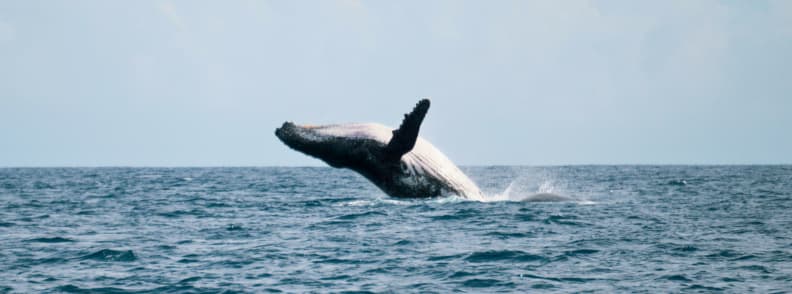
What I’d Do Differently Next Time
I’d come back. Absolutely. But I’d do it differently.
The biggest thing I wish I’d known before visiting La Réunion? We needed more time. Not just to fit in extra hikes or more beach days, but to move slower. La Réunion doesn’t reward rushed itineraries. It’s a place where you need time to adjust, recover, and replan. One wrong turn can take you hours off-course. One mistimed hike can mean no view. One gîte mistake can change the tone of a birthday.
Next time, I’d:
- Travel later in the season, probably October, for warmer evenings and fewer crowds
- Add extra rest days, especially after big hikes
- Bring our son, which will change everything, of course, but we’ve seen how our friends explore the island with a kid, and it’s doable
- Spend more time in one area, instead of constantly moving from place to place
- Book key stays early, especially the gîtes we missed out on the first time.
Is La Réunion worth visiting? Yes, especially if you’re not chasing big cities or polished resorts. This is a destination for slow travelers, couples, solo hikers, and anyone who prefers trails to tours. There’s no show-off culture here. Just landscapes that humble you, food that comforts you, and people who treat you like you live next door.
If you take one thing from this guide, let it be this: plan for the logistics, leave space for the unexpected and be willing to slow down. La Réunion won’t rush for you and that’s a good thing.
Want more? I’ve built a detailed La Réunion travel guide with Rexby, including day-by-day itineraries, hiking routes, and food stops we loved. You can check it out here.
Or, if you’re still in the early stages, bookmark this post. Pack smart, ask locals, and don’t overthink it. You’ll come back changed, just like I did.
About the Author

I’m Mirela Letailleur, a Romanian travel blogger based in the south of France. I write honest, practical guides for curious travelers who like to move at their own pace, skip the fluff, and get things right the first time. No sugarcoating, no sponsored nonsense, just real experiences and the kind of tips I wish I’d had before each trip.
This guide to La Réunion is built from my own experience: hiking the hardest trails of my life, staying in mountain gîtes, eating spicy bol renversé in family-run restaurants, and nearly missing a volcano eruption because of fog. It’s a place that challenged me more than I expected and stayed with me more than I thought it would.
Thanks to Mickaël and Céline for having us, for showing us the island from a local’s point of view, and for sharing the kind of travel advice you won’t find in any guidebook.

